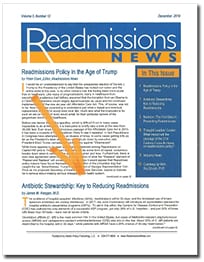PYA recently authored an article for Readmissions News. “Antibiotic Stewardship: Key to Reducing Readmissions” exposes the links between hospital-acquired infections (HAIs), readmissions within 30 days, and the increased use of broad-spectrum antibiotics. It offers succinct guidance for implementing ASPs that can dramatically lower HAI rates and 30-day readmissions.
The article, which is republished with permission of Readmissions News, may be viewed below.
The problems of hospital-acquired infections (HAIs), readmissions within 30 days, and the increased use of broad-spectrum antibiotics are closely intertwined. In 2017, the Joint Commission will introduce an accreditation standard for hospital antibiotic stewardship programs (ASPs). To aid in this effort, the Centers for Disease Control and Prevention (CDC) has outlined the core elements of a successful ASP program, yet only 39% of U.S. hospitals – and just 25% of those with fewer than 50 beds – have met all seven criteria.
Clostridium difficile (C. diff) is the most common HAI in the United States, but cases of Methicillin-resistant staphylococcus aureus (MRSA) and carbapenem-resistant enterobacteriaceae (CRE) also are on the rise. About 20% of C. diff patients are readmitted to the hospital within 30 days,1 while patients with MRSA have a 28% chance of 30-day readmission.2
But here’s the good news: decreasing patients’ total antibiotic exposure significantly decreases C. diff cases (see Figures 1 and 2 below). Decreasing antibiotic exposure also can lower the number of new or returning MRSA and CRE cases.
Designing Successful ASP Programs
Here are some guidelines for implementing an ASP program that can dramatically lower both HAI rates and 30-day readmissions:
Invest in rapid diagnostic technology – Today, many doctors empirically prescribe broad-spectrum antibiotics “just in case” the patient has a bacterial infection. However, it’s now possible to quickly determine whether the patient’s infection is bacterial or viral. If it’s the latter, an antibiotic wouldn’t be effective and therefore shouldn’t be prescribed. The cost of rapid diagnostics is steadily declining – and the technology serves a dual purpose: more effective treatment of the patient and a less detrimental effect on the antibiogram (a community-specific assessment of the effectiveness of antimicrobial drugs).
Establish transitional care clinics – These can provide timely monitoring of patients most at risk of readmission. For example, common risk factors for C. diff readmissions include renal failure, electrolyte abnormalities, anemia, blood coagulation problems, and discharge to home without an appropriate support system.
Educate outpatient and long-term care partners – Beginning in 2017, long-term care (LTC) facilities are subject to the same 30-day readmission penalties that hospitals now face. Yet the staff members at LTCs and outpatient facilities (such as wound care clinics) need more education about how the prescribing of antibiotics can lead to higher readmission rates. Hospitals, outpatient clinics, and LTCs all need to have coordinated strategies for identifying the warning signs of C. diff and other antibiotic-resistant infections.
Make antibiotic stewardship a “top-of-mind” discussion point at important meetings – There should be ASP reports available at all hospital committee meetings (quality, infection control, pharmacy/therapeutics, medical staff departmental meetings, etc.) The ASP program and its results also should be routinely reported at hospital board meetings.
ASPs Are Proving Effective
A recently completed year-long, 30-hospital antibiotic stewardship collaborative in West Virginia produced an overall 16% reduction of broad-spectrum antibiotic use compared to the previous year. In fact, 11 hospitals had a greater than 20% reduction, while four hospitals reduced broad-spectrum antibiotic use by more than 50%.
An ASP program is not a standalone initiative. It’s an integral part of a hospital’s overall strategy for infection prevention, patient safety, improved quality of care, reduced readmissions, and, ultimately, its financial success.
References:
- American College of Gastroenterology study, reported in MedPage Today, Oct. 19, 2016.
- ICHE, June 2012, pp 539-544. Emerson et al. Healthcare Associated Infection and Hospital Readmission.
If you would like more information about creating successful antibiotic stewardship programs or would like to request a speaker for your organization or event, contact one of our executives below at (800) 270-9629.


